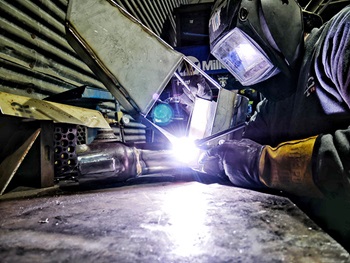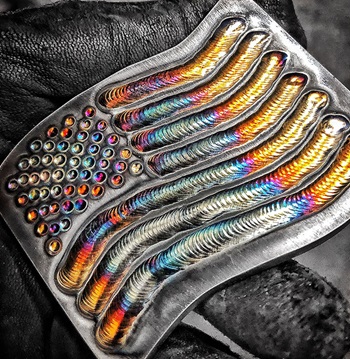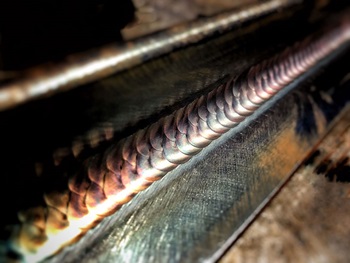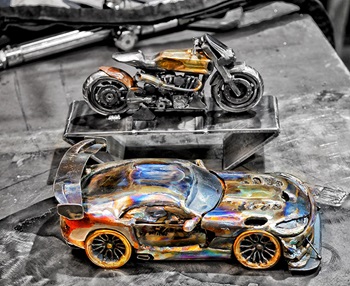Welding Colors: What They Mean and Why They Matter
Print Article
Josh Welton
Owner, Brown Dog Welding
Share
Learn more about the different colors in welds from welder/fabricator Josh Welton of Brown Dog Welding.
You can tell a lot by the color of your weld
The range of colors that occur in welds can shock the senses and stir your imagination. Sometimes these hues are desirable and sometimes they are not. How they appear and why they matter depend on the process, material, industry and application.
To quote Robert Plant, “Lots of people talk and few of them know.” Though I’m not talking about the creation of the soul of a woman, rather the genesis of colors in welds. A rainbow of colors in the bead and heat-affected zone (HAZ) don’t automatically make it a good weld; it can even indicate a bad weld, but not necessarily. This is where the material and application matter.

Why does steel change color?
First things first: Why does steel change color? There’s a lot of science involved and maybe some magic. I’m terrible at explaining science, and chances are you’re not fond of reading science. And if you’re a wizard, you’re probably casting spells instead of welding. Or welding with no need for the likes of me. So, I’ll just give the rest of you a quick and dirty version.
When steel heats up, its entire molecular structure changes. And as the surface of the heated steel meets the atmosphere, it interacts with the elements in the air, creating a chemical reaction. The colors that result depend on the makeup of the metal, the composition of the atmosphere, the temperature at which they meet and the duration of time the metal is exposed at the elevated temperature. The metal is oxidizing.

Oxidation
Surface oxidation is one thing, but deeper oxidation, below the face of the metal, causes porosity. This is where shielding gas or flux comes in, as both are designed to protect the hot welded area from the atmosphere until the bead/HAZ cools to the point where the steel/atmosphere mash-up won’t hurt the steel’s final properties. When somebody tells you that your weld is colored a certain way because you’re welding at a certain temp, they’re only partially right. A lot of factors go into it. Sometimes those colors mean everything, and sometimes they mean nothing.
On stainless steel for example, any color in the weld or HAZ shows that an oxide layer has formed, which can affect corrosion resistance. The darker the color is, the thicker the oxidization. The colors follow a predictable pattern, from chrome to straw to gold to blue to purple. In some industries, like pharmaceuticals, any color beyond chrome in the weld is unacceptable, but in other sanitary welding situations — such as dairy — shades up through light blues are allowed. Those colors can be cleaned off mechanically or chemically, and the corrosion resistance can be restored. And that’s the big deal with using stainless steel, right? Corrosion resistance can be critical.
Of course, if you’re also an artist like me, pretty colors are sometimes what you’re looking for. I’ll often sacrifice rustproofing for the sake of looks. Because of the chemical makeup of something like 308 stainless steel, a little heat can result in some very vivid colors. But mild steel also can produce nice colors, albeit a bit softer; even mixing the two can make for interesting results. I often look for hardened steel pieces like bearing races or old pieces of armor, as the composition lends itself to cool colors when welded and/or heated.

Titanium weld colors
On titanium, the story is kind of the same, but with a big difference. Instead of just compromising corrosion resistance, the contamination from the atmosphere can actually affect the integrity of the weld drastically. Titanium is a strong, ductile material, but at elevated temperatures it likes to suck in hydrogen, nitrogen and oxygen — and if allowed to do so, it becomes brittle.
While not an absolute foolproof indicator, the resulting colors are a pretty good marker of a weld’s strength. Again, it depends somewhat on the industry and use, but typically you'd like the weld and HAZ to come out a bright silver/chrome color, or colorless. Often a light gold color is acceptable (and sometimes beyond that, depending on the application or code). But the less color in titanium, the less chance that it is contaminated or compromised. The caveat here is also similar to stainless: it looks amazing when allowed to react. A lot of hot rod and motorcycle guys will take their chances with material integrity on exposed piping and exhausts because it looks so dang cool when it turns blue and purple.
Final thoughts
Arc length, bead length, temperature of base material, how clean and smooth the surface is, tungsten angle, your motion while welding, the direction you’re welding, if there’s a back purge or backing plate, and post flow all affect the final color, or lack thereof. The best way to learn how is just by welding.
In conclusion, colors in welds are pretty, and many elements play into their creation. Sometimes they indicate a bad weld, sometimes they don’t.

This article first appeared on thefabricator.com. See the original article here: https://www.thefabricator.com/thewelder/article/arcwelding/you-can-tell-a-lot-by-the-color-of-your-weld.